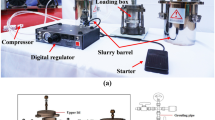Summary
This paper presents results of static and cyclic direct shear tests performed on undisturbed and remoulded samples of Mexico City clays, including results of ‘soil-on-interface’ tests. Experiments show that the static adhesion coefficient depends on the soils' liquidity index and that it diminishes due to the effect of repeated dynamic loads. Dynamic overstrength effects were not apparent, as has been observed when testing this clay in other apparatus. Interface strength in remoulded clays is initially less than half the strength of interfaces with undisturbed materials but it increases with time. At least in the materials tested in this research, it did not equal the strength of interfaces with undisturbed materials. Correction factors derived from experimental data can be used to modify the adhesion coefficient to account for dynamic and remoulding effects.
Similar content being viewed by others
References
Boulon, M. (1988)Contribution a la mecanique des interfaces sol-structures, Memoire d'habilitation, Joseph Fourier University, Grenoble.
Cuanalo, O. (1993) Estudio experimental de interfaces arcilla-concreto (Experimental study of clay-concrete interfaces), MSc Thesis, Graduate School of Engineering, UNAM, Mexico.
Kishida, H. and Uesegui, H. (1987) Tests of the interface between sand and steel in simple shear apparatus,Géotechnique,37, 1, 45–52.
Lee, K.L. and Chan, K. (1972) Number of equivalent significant cycles in strong motion earthquakes, inProceedings of the International Conference on Microzonation, Seattle, Washington, 1972, Vol. 11, pp. 609-17.
Leifer, S.A., Kirby, R.C. and Esrig, M.I. (1980) Effect of radial variation in modulus on stress after consolidation around a driven pile, inProceedings of the Conference on Numerical Methods in Offshore Piling, London, 1979, The Institution of Civil Engineers, pp. 157-63.
Lemos, L. (1986) The effect of rate of shear on the residual strength of soil, PhD Thesis, Imperial College, University of London.
Potyondy, J.G. (1961) Skin friction between various soils and construction materials,Géotechnique,11, 339–53.
Romo, M.P. (1990) Comportamiento dinámico de la arcilla de la ciudad de México y su repercusión en la ingeniería de cimentaciones (Dynamic behaviour of Mexico City Clay and its impact on foundation engineering), inProceedings of the Symposium on The Subsoil of Mexico City and its Relationship with Foundation Engineering, Mexico City, 1991, The Mexican Society for Soil Mechanics, pp. 83–94.
Rosenbleuth, E. and Ovando, E. (1991) Geotechnical lessons learned from Mexico and other recent earthquakes, inProceedings of the Second International Conference on Recent Advances on Geotechnical Earthquake Engineering and Soil Dynamics, St Louis, Missouri, 1991, University of Missouri, Rolla, Vol. 2, pp. 1799–819.
Smith, I. M. (1980) A survey of numerical methods in offshore piling, inProceedings of the Conference on Numerical Methods in Offshore Piling, London, 1979, The Institution of Civil Engineers, pp. 1–8.
Author information
Authors and Affiliations
Rights and permissions
About this article
Cite this article
Ovando-Shelley, E. Direct shear tests on Mexico City clay with reference to friction pile behaviour. Geotech Geol Eng 13, 1–16 (1995). https://doi.org/10.1007/BF00600520
Received:
Accepted:
Issue Date:
DOI: https://doi.org/10.1007/BF00600520




